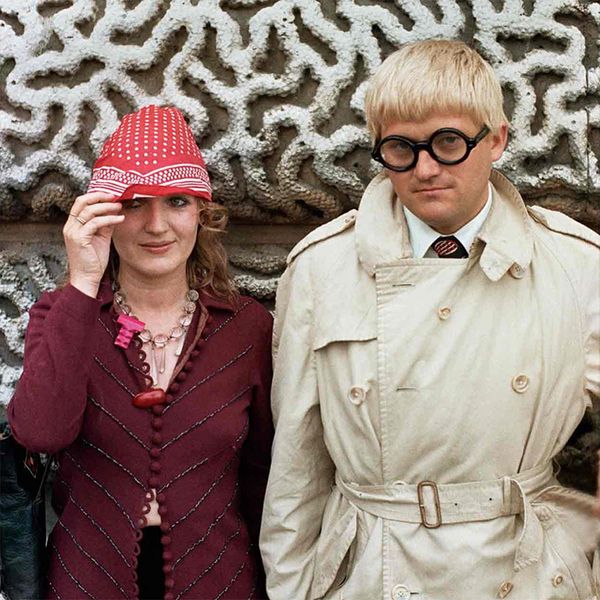Celia Birtwell and David Hockney. © Peter Scheslinger
Since first meeting David Hockney in the 1960s, the British textile designer Celia Birtwell has become a close friend of the artist and arguably his most famous muse. Over the past five decades, Celia sat for Hockney on more than eighty occasions, and her likeness features in approximately a quarter of his printed portraits. Through Hockney’s images of Celia, the artist’s stylistic developments, variations in technique and media, as well as his attitude to portraiture are revealed and celebrated.
Hockney? He has immortalized me. – Celia Birtwell
Born in Bury, Greater Manchester, in 1941, Celia Birtwell studied textile design at the Royal Technical College in Salford. In 1959, she met Raymond ‘Ossie’ Clark, an up-and-coming fashion designer. The pair were married in London in 1969, with David Hockney in attendance as Clark’s best man. Although Clark initially crossed paths with Hockney in the early 1960s and his likeness first appeared in a Hockney painting titled Domestic Scene, Notting Hill in 1963, it was not until 1969 that Hockney made his first portraits of Celia. In an ink drawing simply titled Celia, Paris, 1969, the 28-year-old Birtwell sits slightly stiffly (out of nervousness, she recalled in retrospect) on a chair in a barely furnished Parisian apartment. From this point onwards, Celia continuously features in Hockey’s creative output. Her portrait became a motif in his work as familiar as the swimming pools of Los Angeles or the landscape of Normandy.
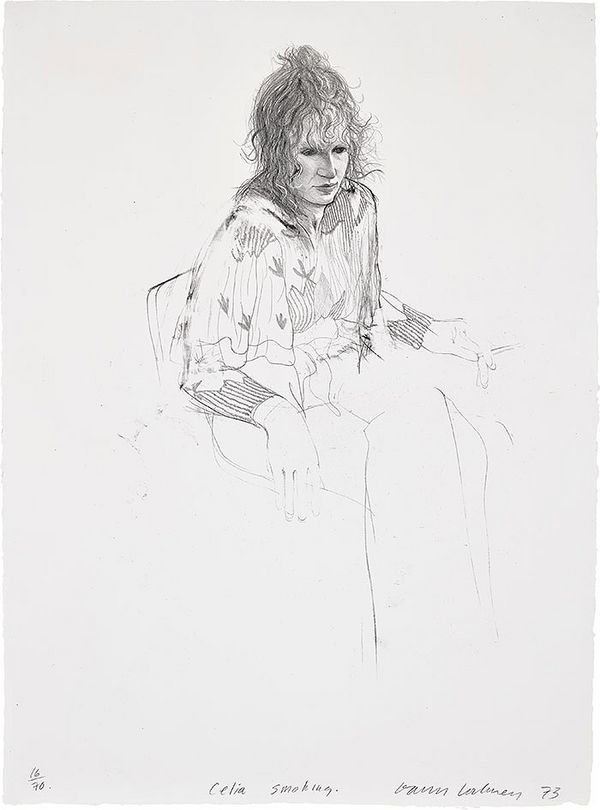
David Hockney, Celia Smoking, 1973.
At the beginning of 1973, Hockney rented a beach house in Malibu, California, and Celia visited along with her two young sons. Birtwell’s marriage to Ossie Clark was already in decline, but the time she spent with Hockney that year clearly acted as a creative catalyst for the artist and made the pair even closer. Hockney produced numerous portraits of Birtwell in 1973, including Celia Smoking. Focusing on his sitter’s face, Hockney conjures up Celia’s likeness through fine monochromatic lines and soft shading. There is particular focus on the rendering of individual strands of Celia’s hair, an element which was also evident in Hockney’s most famous painted portrait of Celia – Mr and Mrs Clark and Percy – a double-portrait of the then newly-wed couple, which is one of the most visited artworks in the Tate Collection. In Mr and Mrs Clark and Percy, Celia stands in a dominant position with her hand on her hip, staring out at the viewer while individual strands of her hair are highlighted by the sun streaming in from the window behind her. By comparison, she appears absorbed in her own thoughts in Celia Smoking. While her expression is pensive, her extremities and surroundings dissipate like the smoke we can imagine emitting from the near invisible cigarette she holds in her left hand. Despite the work’s title, it is less the act of smoking, and more the task of capturing his muse’s mood and demeanor in this quiet moment of contemplation that concerns Hockney.

Celia Birtwell and David Hockney in front of the artist's painting Mr and Mrs Clark and Percy. Image: PA Images / Alamy Stock Photo.
Celia has a beautiful face, a very rare face, with lots of things in it which appeal to me… It shows her intuitive knowledge and kindness, which I think is the greatest virtue. To me she is such a special person. – David Hockney
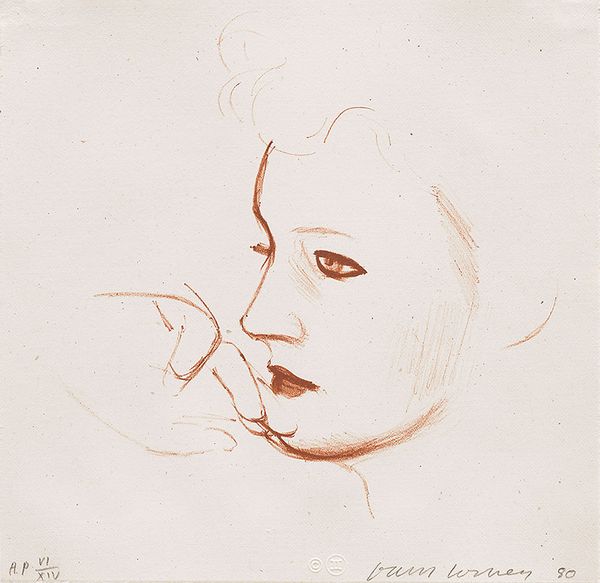
David Hockney, Celia Looks, 1980.
In Celia Looks, 1980, Hockney further reduces Celia’s likeness to essential lines. Depicted in profile, with her hand gently resting on her chin, Celia gazes to the left of the picture plane. Her visage fills the sheet, allowing the viewer to intently examine her in the same way Hockney would have done. Using a heavy line to trace the silhouette of Celia’s profile, Hockney transforms his muse into a regal figure who might adorn a coin face. While Celia’s eyes and lips are also rendered strongly, her likeness again seems to dissolve toward the sheet edge. In these works, it is the idiosyncratic qualities and features of his model that Hockney seeks to accurately portray.
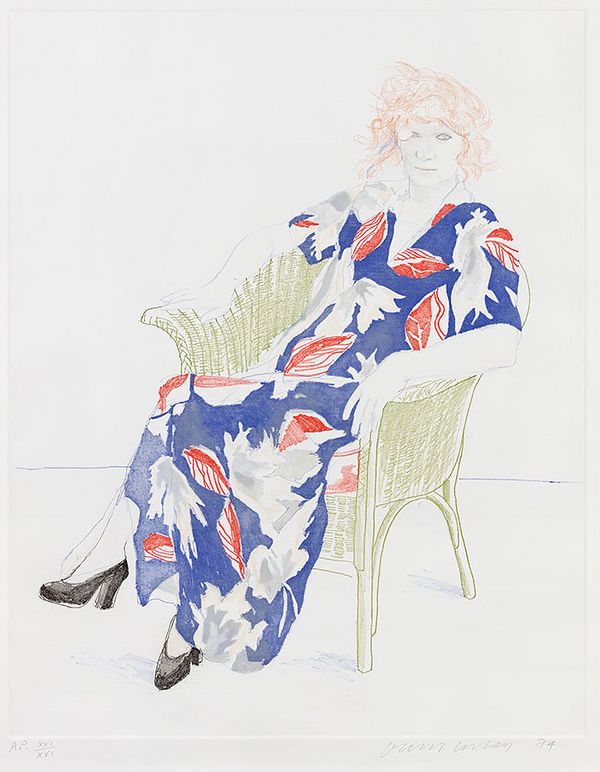
David Hockney, Celia in a Wicker Chair, 1974.
Conversely, Celia in a Wicker Chair, 1974, exemplifies how Hockney favors the portrayal of his sitter’s essential character over capturing a realistic likeness of his model. Adorned in a boldly patterned and brightly colored fabric, Celia’s clothing reveals her personality, creativity, and occupation. Her bright-blonde wavy hair stands out against a ghostly pale and barely defined face, except for her piercing blue eyes, which are outlined in a thick black line and stare back out at the viewer. Aware she is being examined, Celia is poised and positioned in a wicker chair with a reserved expression. This positioning of his subjects – seated with a nondescript or uniform background – frequently recurs in his portraiture. In 2016, the artist exhibited 82 recent portraits of his family and friends, including Celia Birtwell, at the Royal Academy in London. Each model sat on the same yellow upholstered chair in front of the same blue curtain, with their likeness captured on canvases of identical size. By standardizing their surroundings, the focus of each work becomes Hockney’s sitters and what his creative choices convey about his relationship with those depicted. Celia in a Wicker Chair predates these later portraits by several decades, but the comparison demonstrates Hockney’s long-lasting interest in capturing the essence of a person through his artwork.

David Hockney, Celia Making Tea, 1982.
Influenced by two major Picasso retrospectives held at the Museum of Modern Art and the Walker Art Center in 1980, Hockney began to search for a way in which he could convey multiple viewpoints within one image. Surprisingly, it was the medium of photography that Hockney selected for his experiments – a medium he had previously criticized for relying on a fixed-perspective. To emulate the Cubist master, Hockney created composite Polaroid works: one subject shot from varying viewpoints with the photographs then assembled into one final image. Moving from a Polaroid camera to a Pentax 110 to avoid the white borders produced by the former device, Hockney utilized photographic collages to portray Celia Birtwell once again. In Celia Making Tea, approximately twenty different photographs are taken, printed, and reconstructed into a fragmented portrait. They depict Celia dipping a tea bag into a cup in a yellow-lit room in New York while she engages in conversation with a friend. As Hockney hoped, the format of the photographic collage encourages the eye to move around the image, replicating how we experience scenes visually. Simultaneously, the arrangement encourages the viewer to dwell on each individual photograph in an attempt to understand how the final work is constructed. In a complete break with the traditional convention of portraiture, Celia’s face is barely visible. Celia Making Tea is Hockney’s declaration that a successful portrait of someone should convey to the viewer how they would experience seeing the person in front of them if they were in the same room.
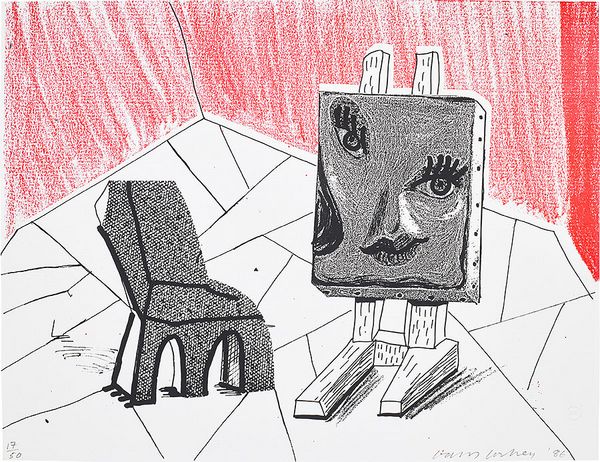
David Hockney, Celia with Chair, 1986.
In 1986, Hockney stumbled upon another innovative way to construct an image. While experimenting with an office photocopier, the artist realized that the machine could be used to replicate the traditional process of color printmaking, without requiring an expert printmaker to assist with the complex method of accurately layering each color. This revelation marked the commencement of Hockney’s ‘Home Made Prints’ series, which, perhaps unsurprisingly, featured Celia Birtwell once again. Celia with Chair solidifies Hockney’s interest in the multiple perspectives used by the Cubists. The room depicted is void of perspectival depth, with floor tiles jutting out at disorienting angles and multiple viewpoints of a chair combined into an abstracted form. On the easel, a canvas is situated containing Celia’s facial features depicted in a simplified and disorderly fashion akin to Picasso’s portraits of Dora Maar. Celia is now portrayed in the picture plane through her own portrait, and it is her portrait that defines her presence rather than her actual likeness. While Celia in a Chair exemplifies yet another artistic technique championed by Hockney, it also attests to the importance and productivity of his creative partnership with Celia Birtwell and his constant engagement with the core question: what is a good portrait?
Recommended Reading
Miles Off It: An Amateur's Guide to Running with David Hockney >
